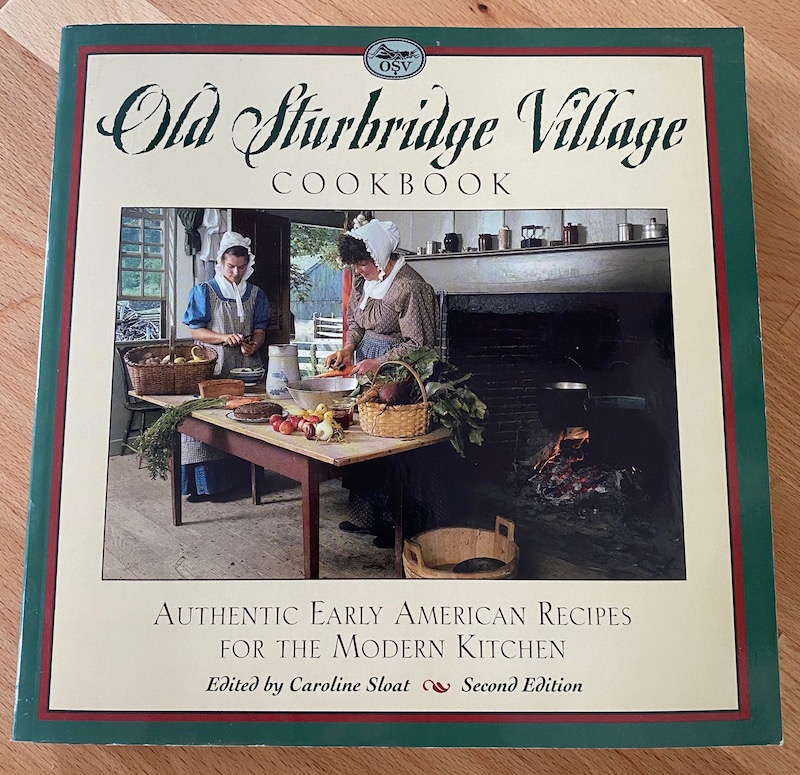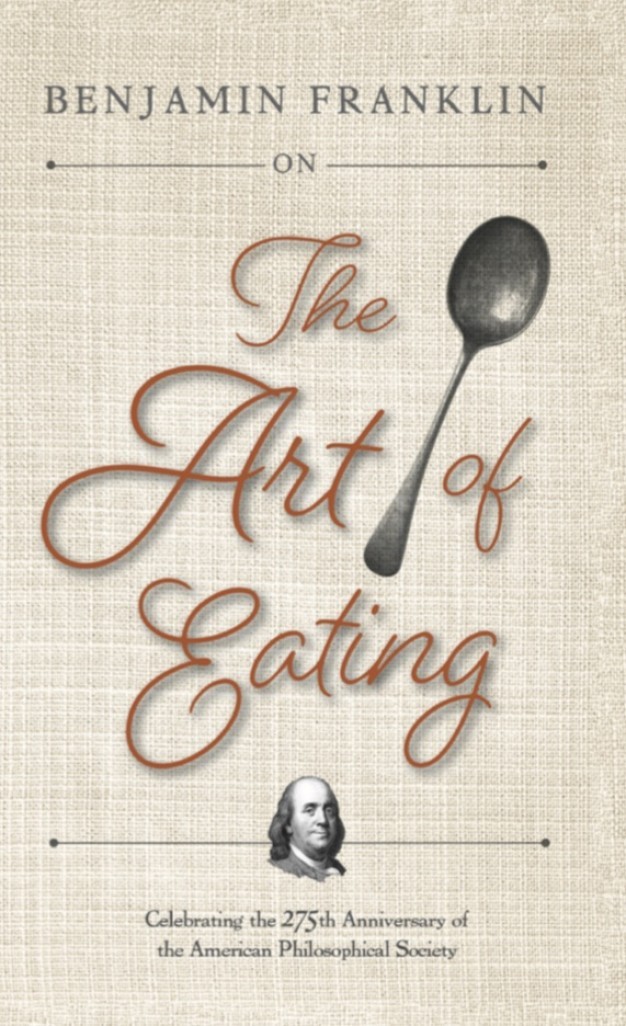Revisiting Benjamin Franklin and the Art of Eating: Caroline Sloat
Over the past few weeks, we have explored a series of cooking recipes found in the American Philosophical Society’s collection of Benjamin Franklin’s manuscripts. Nearly sixty years later, these recipes challenge us to think about Franklin, eighteenth-century foodways, and our modern-day fascination with historic recipes. We’ve certainly taken these recipes in directions that APS Member and French-born literary critic Gilbert Chinard (1881-1972) might not have imagined when he published Benjamin Franklin on the Art of Eating (1958). (The book is still in print. Order your copy here.)
This week’s conversant: Caroline Sloat

For the fourth in our series, we caught up with Caroline Fuller Sloat. Caroline retired from the American Antiquarian Society where she served as editor of publications and director of scholarly programs. Before that she had a long career at Old Sturbridge Village (OSV) where, as a research historian, she helped prepare the Asa Knight Store as a museum exhibit and reevaluated the furnishings of the houses and the interpretation of the historical community. This was the time when vibrant new scholarly work about women and African Americans of the Early Republic could be introduced as interpretive scenarios around the museum. More historically based cooking demonstrations were one of the supports for the revised interpretation, and she researched and compiled The Old Sturbridge Village Cookbook: Authentic Early American Recipes for the Modern Kitchen (first ed., 1984).

During this period of quarantine, we have seen many museums sharing historical recipes. Why do you think recipes from the past are so interesting for people?
The short answer is that it’s a taste of the past. When I was working in an outdoor history museum, one of the most frequent visitor questions at the hearth cooking demonstrations was about a source for the recipe. The study of historical foods has evolved from the study of early nineteenth century cookbooks merely to reproduce recipes into an academic field that gives serious consideration to larger questions based on food as evidence. In a living history museum, the foodways of the people whose lives are interpreted in the museum can be recaptured through the gardens, from the collections of cooking and eating utensils, and documentary sources. Demonstrations involving each of these areas conducted by skilled and knowledgeable staff inspire visitors to watch, to ask questions, and learn informally. Families can observe how fire--an amazing attraction for young people—can be harnessed in many useful ways that might inspire an interest in history (for the extent of the visit, even if not for longer). When tried at home, recipes from the past are a good complement to a history lesson, an intergenerational activity even in quarantine, and sometimes one finds a recipe that becomes part of the household repertoire. The fan letters I received after the publication of the Old Sturbridge Village Cookbook also came from reenactors and their families who were happy to have historical recipes to prepare during their encampments.
What goes into translating historic recipes for modern audiences?
I was fortunate enough to have the resources of an outdoor history museum with experienced hearth cooks. Our collaboration helped me understand their preparation and cooking techniques, many of which are implied because a “recipe” might be little more than a list of ingredients. Or in Lydia Maria Child’s case, involving her great spoon as a favored measuring tool--I used a large antique spoon that I own. The American Frugal Housewife (Boston, 1833) was a good match for the interpretation and collections at OSV because the recipes generally call for ingredients that were grown or found in rural stores and equipment that inventories and other research showed to be available. Another key group of collaborators were my Research Department colleagues who were willing to taste and opine on recipes that I cooked on my stove at home for potential inclusion.
What do Franklin’s writings and recipes have to tell us about the early American foodways and the marketplace?
I wish that more couples such as Benjamin and Deborah Franklin communicated about culinary and domestic subjects in their daily lives and correspondence. He appears to have appreciated her cooking and gratefully received shipments of prepared roasts, mince pies, and barrels of fruit she sent across Pennsylvania, as well as the grains, fruits, and nuts that she shipped to him while he was in Europe. He addressed his negative opinion about shipboard dining—even at the captain’s table--with a list of provisions and simple cooking equipment for a traveler with a servant to be able to prepare a meal that resembled fare at home.
On the face of it, Franklin’s writing about American foods and their cooking techniques describe mid- to late-eighteenth century cuisine. Beyond Indian corn, such grains as oats, wheat, rye and barley were baked and brewed. Pigs, beef, and poultry were raised for the market. Oyster beds were still found on the American coast and they were regularly harvested. American dairies produced milk, butter, and cheese. Trade supplied rice, lemons, coffee and chocolate. Imported tea might be rejected for political reasons, but he points to homegrown herbal substitutes. Vegetable gardens may have been beyond his gaze, although carrots, celery root, shallots, and sage are mentioned in the recipes.
One could wish to know more about how food came into the Franklin house. Who shopped at the public market and what was there? Who and what were reflected in the mix of foodstuffs that made their way to the Franklin’s tables?
Franklin’s reflections on American food while in Paris reveal both his sharpened taste for the plain food he was accustomed to and the attraction of French patisserie, bonbons, and glacées. While in France, Franklin learned the value of eating and drinking in moderation. He presented American cooking and dining as plain in taste and moderate in quantity in contrast to the richness and expense of French cuisine. Many of his ideas about food that came from books and reading appear to have been incorporated in his own writings and authors with whom he discussed food.
A particular strength of Franklin’s description of food is the case that it makes for its inclusion in the marketplace of ideas. His experience in conversation around a table set with punch or a full meal sharpened his insight into the politics of what was being served. Through reading and conversation Franklin learned that foods were more than hospitality and nourishment. They spoke to class and nationality. Those having the luxury of choice could manipulate descriptions of their diet to define identity.
That said, his description of using an electrical shock to butcher a turkey with the assistance of an electrical jack seems fanciful and does suggest that he might not have known as much about food and cooking as he claimed.
Gilbert Chinard confidently stated in 1958 that Franklin was an “uncommon man whose singular merit was to exemplify many of the virtues and some of the weaknesses of the common man”? Do we still believe that today?
One could respond, “Yes, he did that very well,” but such singularity is not the question that animates historians today. I would say that Franklin had a broader vision. He sought to define the residents of the colonies and then the nation as curious, hardworking, educated, tolerant…and the list goes on. He had many opportunities to define American-ness through his leadership at home and abroad. If every American could work on purposeful achievements in any one of the areas in which Franklin worked, that would be many lifetimes well spent and add up to the greatness that he envisioned.
Which recipe in Franklin’s recipe book intrigued you most and why?
That’s a tough one! Is it worth adding wine to oat milk? If I had an equipped hearth, I’d gladly prepare the suckling pig; it would be moist and delicious. I would probably have to settle on the mincemeat, as I can visualize all the steps (and some of the inevitable substitutions, as I would be working alone and it calls for a lot of chopping and peeling). I would need to find a source for sheep suet or be satisfied with beef from the local supermarket. It would also be helpful to know the volume of the stone pot that is recommended for storage during the four months marinating in a cool cellar. The aroma of baking pies would motivate me to try this once to see how it compares to say, a jar of Robertson’s mincemeat imported from Britain.
The Recipe
The APS is currently undertaking strong social distancing measures to help slow the spread of the novel coronavirus, COVID-19. Thus the APS offices and the Library are closed and we cannot share with you an image of the original recipe. However, we can share a transcription of it, along with a contemporary English version.
Original French recipe in Franklin’s papers:
Pour rôtir un Cochon de Lait
Avant de mettre le Cochon de Lait devant le feu, prenez un peu de Sauge hachée très menu, un morceau de beurre gros comme une noix et un peu de poivre et de Sel, mettez les dans le Cochon, et cousez le avec du gros fil. Saupoudrez le jusqu’a ce que les Yeux tombent, ou que la peau soit bien rissolée. Soyez très attentif à recevoir tout le Jus qui tombe du Cochon, en mettant dessous, aussitôt que vous voyez qu’il en tombe, des Jattes ou des Poélons, que vous placerez dans la Léchefritte.
Quand le Cochon est assez rôti faites un feu clair prenez un torchon propre et mettez dedans un Quar- tron de beurre et frottez le Cochon avec, jusqu’à ce que la peau soit parfaitement rissolée. Ensuite tirez le Cochon du feu, mettez le dans un plat, coupez la tête et coupez le cochon en deux avant de le tirer de la broche. alors coupez les Oreilles et mettez en une à châque bout du plat, coupez aussi la machoire de des- sous et mettez en une partie de chaque côté. fondez un peu de beurre, prenez le jus que vous avez conservé et mettez le dans votre beurre et faites le bouillir versez le tout dans le plat avec la servelle de Cochon coupée par morceaux et mêlée avec la Sauge, et servéz le ainsi sur la table.
Gilbert Chinard’s Recipe (from Hannah Glasse’s The Art of Cookery, c. 1760)
To roast a pig.
Spit your pig and lay it to the fire, which must be a very good one at each end, or hang a flat iron in the middle of the grate. Before you lay your pig down, take a little sage shred small, a piece of butter as big as a walnut, and a little peper and salt; put them into the pig and sew it up with coarse thread, then flour it all over very well, and keep flouring it till the eyes drop out, or you find the crackling hard. Be sure to save all the gravy that comes out of it, which you must do by setting basons or pans under the pig in the dripping-pan, as soon as you find the gravy begins to run. When the pig is enough, stir the fire up brisk; take a coarse cloth, with about a quarter of a pound of butter in it, and rub the pig all over till the crack- ling is quite crisp, and then take it up. Lay it in your dish, and with a sharp knife cut off the head, and then cut the pig in two, before you draw out the spit. Cut the ears off the head and lay at each end, and cut the under jaw in two and lay on each side: melt some good butter, take the gravy you saved and put into it, boil it, and pour into the dish with the brains bruised fine, and the sage mixed all together, and then send it to table.


